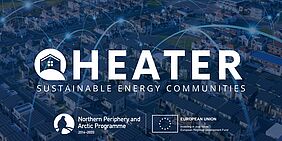A new Clustering project, HEATER-Heat and Energy Empowerment and Education in Rural Areas, has been approved under the EU Interreg Northern Periphery and Arctic Programme (NPA), bringing together a consortium of five separate projects, with complimentary themes and synergies in the field of energy efficiency in northern territories.
With a combined budget of over €154,000, HEATER, led by the Northern Ireland Housing Executive, will bring together Letterkenny Institute of Technology, Ulster University, and Oulu University of Applied Sciences in Finland. The Cluster is one of 6 such projects approved under the Interreg NPA programme.
NPA Clustering projects are 12 months duration and combine 2 or more previously completed, or ongoing, NPA projects under a similar theme. Clustering offers a unique opportunity to diversify and to capitalise on outputs and results; further integrating results as well as disseminating their impacts. Thus, reaching a wider group of stakeholders with project outputs, supplementary learnings, and capacity building.
The HEATER Cluster will see a merger of projects HANDIHEAT (led by the Northern Ireland Housing Executive), SMARTrenew (led by LYIT), e-Lighthouse (led by Oulu University of Applied Sciences) and SENDdoc and TechSolns (both led by Ulster University), all addressing similar themes and territorial challenges in the field of energy efficiency.
Leader of project HEATER, Robert Clements, of the Northern Ireland Housing Executive, noted that the new Cluster project will seek to amass the resources of the existing projects and partners to transfer knowledge and good energy practices to a wider audience. “One of our key drivers at the Northern Ireland Housing Executive is to reduce fuel poverty and energy consumption for householders by building greater awareness of good energy saving practices and energy efficiency measures. Under project HANDIHEAT, our main focus was to address key challenges to improve energy efficiency and renewable solutions for rural communities through the development of resources to both empower and educate peripheral communities. Through HANDIHEAT, we have formulated invaluable toolkits, guides, and roadmaps to tackle fuel poverty and the over reliance on fossil fuels in rural areas. “
“Under project HEATER, we will aim to combine and merge these existing key resources and networks with those of our partners in LYIT, University of Ulster and Oulu University of Applied Sciences to build greater social sustainability and energy stability. The combined expertise under the new HEATER cluster, will allow us to add value by optimising our networks and bringing together a wider stakeholder base, to inform decision and policy makers in our respective regions through a host of dissemination activities such as conferences and webinars.“
Dr Nick Timmons, of LYIT, leader of project SMARTrenew, and partner in the HEATER cluster project, explains that cross-border and transnational cooperation is key to addressing the challenges posed by the transition to a low carbon economy in rural areas. “Under project SMARTrenew, we are developing 7 innovative smart renewable energy pilots across 6 northern EU countries aimed at increasing renewable energy implementation and energy storage solutions. These colder and more rural territories are still very much reliant on fossil fuels."
“Like SMARTrenew, HEATER has a strong cross-border and transnational dimension, and we know that the energy transition poses greater challenges in these areas, with communities more vulnerable to the risk of energy poverty and inequality. Through our respective projects, all partners have developed a set of important resources and networks and by combining these in project HEATER, we can achieve much greater impacts beyond the lifespan of our existing projects.”
Professor Joan Condell, of Ulster University and leaders of project SENDoc and TechSolns noted that “Research conducted under Ulster University’s SENDoc and TechSolns projects, has highlighted how rural, peripheral communities, with an aging demographic, are particularly vulnerable to isolation not only in health, but also in areas like energy security, which can have a profound effect on wellbeing; taking into consideration both pre and post COVID periods of time. By amalgamating our shared learnings under project HEATER, we can target a wider audience and harder to reach groups such as older people.”
Dr Antti Kemppainen, of Oulu University of Applied Sciences, Finland, outlined that the new HEATER Cluster project will build on the learnings and outputs from project e-Lighthouse. “Through project e-Lighthouse, an extensive retrofit programme was initiated with partners across the NPA, and a range of energy reduction and storage solutions were also identified. At Oulu University of Applied Sciences, we believe that the learnings and outputs from project e-Lighthouse could be transferred to other regions to address the challenges in energy efficiency and through the new HEATER Cluster, we look forward to collaborating with our transnational partners to increase our stakeholder base.”
To find out more about the Northern Periphery and Artic Cluster project HEATER visit the project website at https://heater.interreg-npa.eu/

